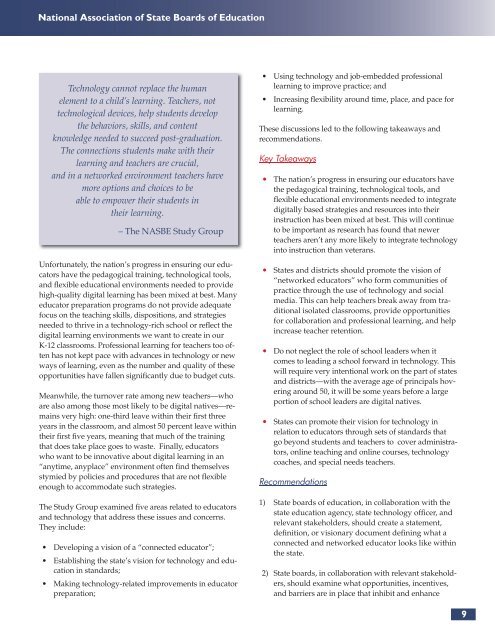You also want an ePaper? Increase the reach of your titles
YUMPU automatically turns print PDFs into web optimized ePapers that Google loves.
National Association of State Boards of Education<br />
Technology cannot replace the human<br />
element to a child’s learning. Teachers, not<br />
technological devices, help students develop<br />
the behaviors, skills, and content<br />
knowledge needed to succeed post-graduation.<br />
The connections students make with their<br />
learning and teachers are crucial,<br />
and in a networked environment teachers have<br />
more options and choices to be<br />
able to empower their students in<br />
their learning.<br />
– The <strong>NASBE</strong> Study Group<br />
Unfortunately, the nation’s progress in ensuring our educators<br />
have the pedagogical training, technological tools,<br />
and fl exible educational environments needed to provide<br />
high-quality digital learning has been mixed at best. Many<br />
educator preparation programs do not provide adequate<br />
focus on the teaching skills, dispositions, and strategies<br />
needed to thrive in a technology-rich school or refl ect the<br />
digital learning environments we want to create in our<br />
K-12 classrooms. Professional learning for teachers too often<br />
has not kept pace with advances in technology or new<br />
ways of learning, even as the number and quality of these<br />
opportunities have fallen signifi cantly due to budget cuts.<br />
Meanwhile, the turnover rate among new teachers—who<br />
are also among those most likely to be digital natives—remains<br />
very high: one-third leave within their fi rst three<br />
years in the classroom, and almost 50 percent leave within<br />
their fi rst fi ve years, meaning that much of the training<br />
that does take place goes to waste. Finally, educators<br />
who want to be innovative about digital learning in an<br />
“anytime, anyplace” environment often fi nd themselves<br />
stymied by policies and procedures that are not fl exible<br />
enough to accommodate such strategies.<br />
The Study Group examined fi ve areas related to educators<br />
and technology that address these issues and concerns.<br />
They include:<br />
Developing a vision of a “connected educator”;<br />
Establishing the state’s vision for technology and education<br />
in standards;<br />
Making technology-related improvements in educator<br />
preparation;<br />
Using technology and job-embedded professional<br />
learning to improve practice; and<br />
Increasing fl exibility around time, place, and pace for<br />
learning.<br />
These discussions led to the following takeaways and<br />
recommendations.<br />
Key Takeaways<br />
The nation’s progress in ensuring our educators have<br />
the pedagogical training, technological tools, and<br />
fl exible educational environments needed to integrate<br />
digitally based strategies and resources into their<br />
instruction has been mixed at best. This will continue<br />
to be important as research has found that newer<br />
teachers aren’t any more likely to integrate technology<br />
into instruction than veterans.<br />
States and districts should promote the vision of<br />
“networked educators” who form communities of<br />
practice through the use of technology and social<br />
media. This can help teachers break away from traditional<br />
isolated classrooms, provide opportunities<br />
for collaboration and professional learning, and help<br />
increase teacher retention.<br />
Do not neglect the role of school leaders when it<br />
comes to leading a school forward in technology. This<br />
will require very intentional work on the part of states<br />
and districts—with the average age of principals hovering<br />
around 50, it will be some years before a large<br />
portion of school leaders are digital natives.<br />
States can promote their vision for technology in<br />
relation to educators through sets of standards that<br />
go beyond students and teachers to cover administrators,<br />
online teaching and online courses, technology<br />
coaches, and special needs teachers.<br />
Recommendations<br />
1) State boards of education, in collaboration with the<br />
state education agency, state technology offi cer, and<br />
relevant stakeholders, should create a statement,<br />
defi nition, or visionary document defi ning what a<br />
connected and networked educator looks like within<br />
the state.<br />
2) State boards, in collaboration with relevant stakeholders,<br />
should examine what opportunities, incentives,<br />
and barriers are in place that inhibit and enhance<br />
9


